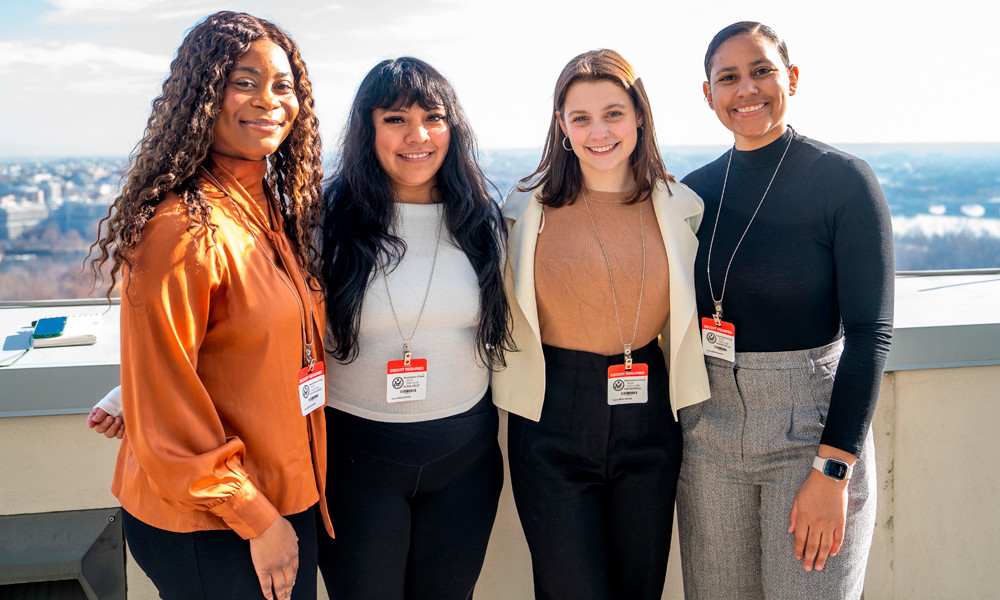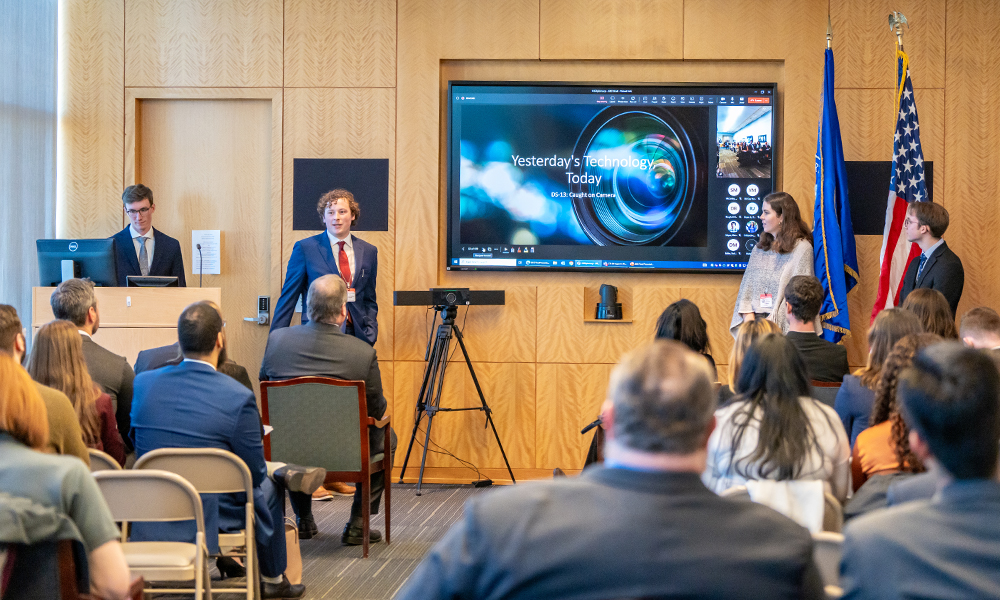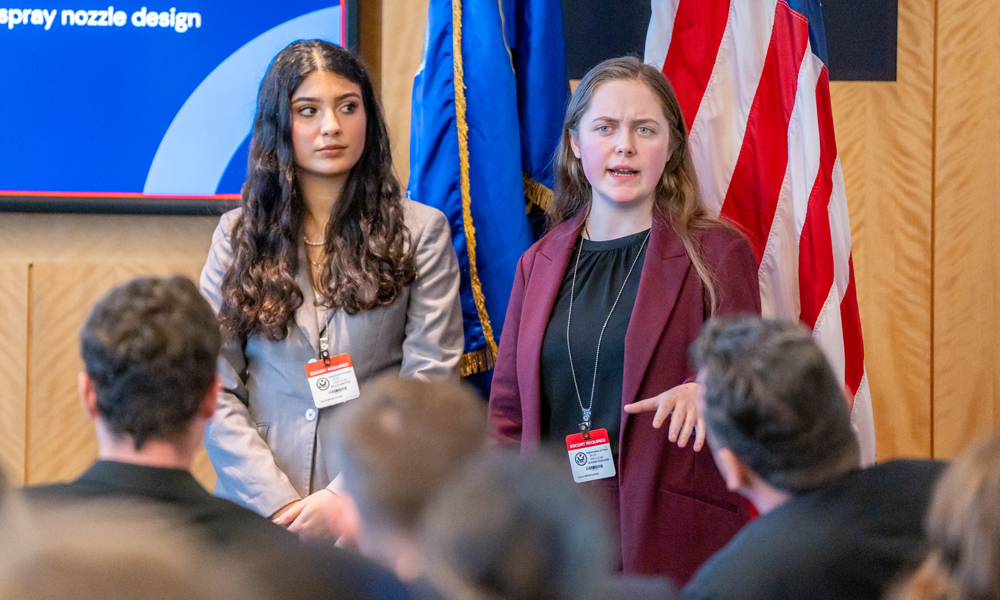Students tackle real-world U.S. security issues abroad
News
SUMMARY: Students in JMU’s Hacking for Diplomacy class tackle threats to national security by using strategic, problem-solving skills and working closely with professionals in the field. Their final presentations in Fall of 2023 took them to Washington, D.C., where they shared their creations with the U.S. Department of State.
After months of hard work, students in JMU’s Hacking for Diplomacy course boarded a bus to Washington, D.C., in December to pitch their ideas for protecting U.S. diplomatic interests abroad to officials at the Department of State.
The interdisciplinary class brought together students from Mathematics; Writing, Rhetoric and Technical Communication; and Political Science.
H4Di is supported by BMNT Inc. and the Common Mission Project, which strives to put students in conversation with members of the defense and intelligence communities to create innovative solutions to “wicked problems" through courses like Hacking for Diplomacy, Hacking for Defense and Hacking for Homeland Security.

The course implements the Lean LaunchPad methodology created by adjunct professor Steve Blank at Stanford University. The idea behind the method is to “fix the problem like how you would pitch a startup company,” said JMU political science professor Bernie Kaussler.
The class, taught in the Fall 2023 semester by Kaussler, Séan McCarthy and Hala Nelson, tasked students with finding solutions to five unique threats against U.S. national security. Students worked in teams with the Diplomatic Security Service, the principal security and law enforcement agency of the Department of State. Each group pursued their assignments with the goal of creating a feasible prototype by paying attention to cost and efficiency.
|
“The opportunity to present in Washington elevated our project by adding a healthy pressure. We were no longer just presenting to our professors, but instead presenting an innovative solution to a real-world problem to those who are engaging with our problem every day.” — Adonis Ortiz |
“The opportunity to present in Washington elevated our project by adding a healthy pressure,” said Adonis Ortiz, a member of the group Less Than Lethal. “We were no longer just presenting to our professors, but instead presenting an innovative solution to a real-world problem to those who are engaging with our problem every day.”
Each group had a problem sponsor, a Department of State employee with knowledge of the problem and the DOS ecosystem, who kept them on the right path. “Our sponsors were very special … They not only answered our questions and concerns, but they also allowed us to work alongside them, taking our recommendations in real time and implementing them,” said Ai Vy Le, a member of the group Longer Lifespan, Longer Security. “Our sponsors pushed us to dig deeper and solve this problem not just at a surface level, but at the level an actual employee would.”
DSS put a heavy emphasis on policy recommendations, although a few of the groups proposed physical solutions as well.

Fourth-year student Henry Donovan was one of four members of the group Caught on Camera, which strived to modify the language used in the newly modernized digital security camera system policy in the hopes of increasing efficiency. The team traveled to Marine Corps Base Quantico in Virginia in October to interview U.S. Marines about some of the learning curves they’ve faced with the implementation of the new system. “Our interviewees were far more educated on the topics at hand than us, and letting them take the reins often yielded information that was more relevant to our problem,” Donovan said.
|
“Our sponsors pushed us to dig deeper and solve this problem not just at a surface level, but at the level an actual employee would.” — Ai Vy Le |
Another group, Less Than Lethal, aimed to stay true to its name by designing a multitier defense system to better protect U.S. Embassy buildings and personnel abroad. “We had the privilege of working on this project for more than four months, learning more than we could have ever expected,” Ortiz said. “Through this class, I have learned to value three essential skills: communication, multitasking and transparency. ... Each skill highlights what it takes to be an effective leader.”
The group TMI, or Two Much Inventory, was tasked with trying to fix the inefficiency of asset storage within the Department of State. Members adopted a two-pronged approach: augmented reality and geographic mapping.
Longer Lifespan, Longer Security confronted challenges on the path to a final prototype. Their project evolved from trying to maximize the life cycle of X-ray machines and explosive-device itemizers to building a structured data-management framework that could be implemented in any device.
|
“Being able to actually speak to the people whose day-to-day lives we were making a difference in took our resolve to a higher level.” — Henry Donovan |
“We recognized the need for a more expansive, long-term perspective,” Le said. “[W]e had to build a structured data-management framework that could life cycle any device that the Department of State may try to implement in the future … This endeavor transcended a short-term commitment for the semester; instead, it established a lasting solution that extends far beyond our own lifetimes.”
The fifth group, Mystery Risks, proposed solutions to chemical, radioactive and biological threats faced by embassy workers, such as the mysterious Havana syndrome, which has affected more than 40 U.S. Embassy workers. Although they soon discovered that no one device could prevent all three threats, their research led them to suggest a web-like system in which embassy workers wear detectors for one of the three risks, thus making the building itself a detection device for all three categories.

The students’ on-the-ground experience took them much farther than Washington, with a select group traveling to Costa Rica to visit the U.S. Embassy. “Being able to actually speak to the people whose day-to-day lives we were making a difference in took our resolve to a higher level,” Donovan said. The ability to be on the soil of a real U.S. Embassy elevated the research process of the students attending as it allowed them to see more clearly what their projects were working toward.
Students also got the chance to dine with Mike Flores, deputy chief of mission of the U.S. Mission to Costa Rica, who, after meeting the students, came to the District to attend their final presentations.
“I was so impressed by the group of students who visited Costa Rica,” Flores said. “They are bright, energetic and have a high level of emotional intelligence. These students reaffirm my confidence in the future for our institution and the country.”

